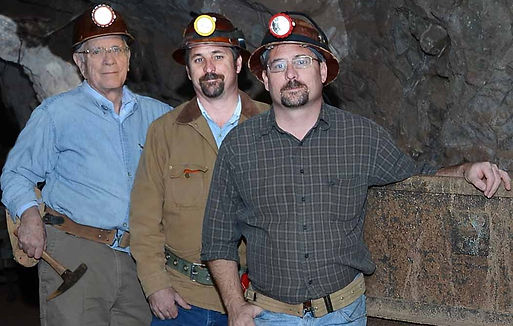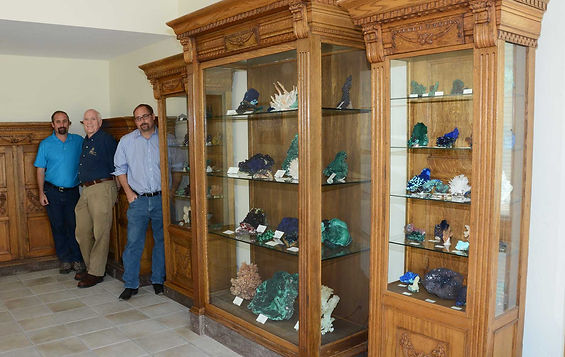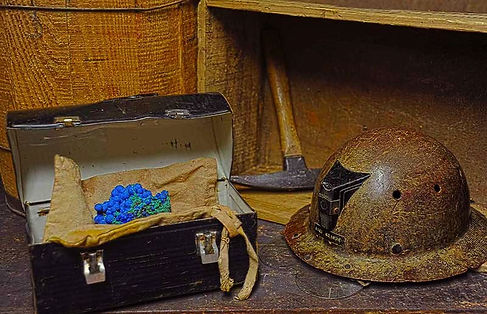bio

Richard Graeme III Doug Graeme Richard Graeme IV
Bisbee and the Graeme family: Our connection to Bisbee began in 1883, when Charles Keeler came to this young mining camp, as a boy, seeking work, which he quickly found in the Copper Queen Mine. For most of the next 62 years he would call Bisbee his home and mining his trade. He retired in 1945, but continued to live close to the Cole Shaft where he had spent so many working days. Charles was our grandfather/great-grandfather and it was his many stories and reminisces that kindled a life-long interest within Richard Graeme III for all things Bisbee, most of all the minerals as he was a mineral collector. The legacy of Keeler’s interest continues with unabated passion in Richard Graeme IV and Douglas Graeme. Together, we have put together the largest and most complete collection of Bisbee minerals with some 7,000 specimens. This coupled with an extensive research library and a historic photograph collection of more than 6,000 images provide an unparalleled information basis for the telling of Bisbee’s colorful past.
I'm a paragraph. Click here to add your own text and edit me. I’m a great place for you to tell a story and let your users know a little more about you.

Richard (Dick) W. Graeme III: Born Bisbee, Arizona in 1941 and was an active collector of Bisbee minerals by age six. While most boys of his age chose baseball and other, more typical activities, Dick preferred the pursuit of minerals in the many miles of underground workings, then accessible. By his early teens, he had amassed a good collection of minerals and was well known to mineral dealers and other collectors as a source of specimens. In 1959, while looking for minerals in the Cole Mine, he collected a specimen that would later be recognized as a species new to science and which would be named graemite in his honor (Williams and Matter, 1974).
Dick went to work in the mines in 1960 as a laborer where he would remain for the next dozen years during which he completed a BS in Geological Engineering in 1972 at the University of Arizona. Subsequently he was promoted to Resident Geologist of the Copper Queen Branch. With the closure of the mines, Dick left Bisbee, but continued to study its mineralogy, geology and history while writing about all of these aspects (Graeme, R.W., 1981, 1987, 1993, 1999, 2008, 2012a, 2012b). Today, he still works in the copper industry outside of the U.S. in senior management positions.
Richard (Rich) W. Graeme IV: Born Bisbee, Arizona in 1968 and was collecting underground with his father and twin brother by age six. Minerals and mining were the focal points of his youth, with many hundreds of hours spent underground in Bisbee and other western mining areas collecting minerals and mining artifacts. In 1986, along with his twin, he collected what is surely Bisbee’s finest cuprite specimen along with exceptional examples of some of the rarest of copper minerals.
Rich has worked in the gold fields at Nome, Alaska, the fabled Sunnyside Mine at Silverton, Colorado and in the Continental Mine near Silver City New Mexico as well as the Golden Queen Mine near Mojave, California, gaining first-hand experience in underground mining. Later, he worked in Bisbee at the Queen Mine Tours as a guide, where his knowledge base was put to full use.
Because of the difficult times for the domestic mining industry, Rich switched from a mining major to education and received his degree in education from the University of Arizona in1999. He now teaches science in nearby Sierra Vista.
Douglas (Doug) L. Graeme: Born in Bisbee, Arizona in 1968, he was underground and collecting minerals and artifacts by the age of six. From that point on, his focus has been on Bisbee and its incredible mineralogy interspersed with mineral finds elsewhere. Most of his free time as a young boy was spent underground in the successful quest for minerals and mining related memorabilia. The news and significance of his discoveries were shared with fellow collectors when, beginning at age 13 he and his brother made frequent presentations at the New Mexico Mineral Symposium.
While he collected many fine minerals in his teen years, nothing compares to the extraordinary cuprite he collected with his twin in the Southwest Mine. Along with what is one of the world’s best cuprites, he also collected a diverse suite of rare and uncommon copper minerals, some of which remain the best examples known for the species.
By the time Doug had completed three years of university studies with a mining major, the U.S. mining industry was well into its decline. Nonetheless, he worked on the surface on the gold dredges of Nome, Alaska and underground in the specimen-rich Sunnyside Mine near Silverton Colorado as well as in the Continental Mine in Fierro, near Silver City New Mexico. Later he would work at the Queen Mine Tours as a guide then in Kartchner Caverns during its development using his mining experience. Now Doug has returned to work in Bisbee as the Manager for the Queen Mine Tours where his passion and knowledge help keep the legend of Bisbee alive.
